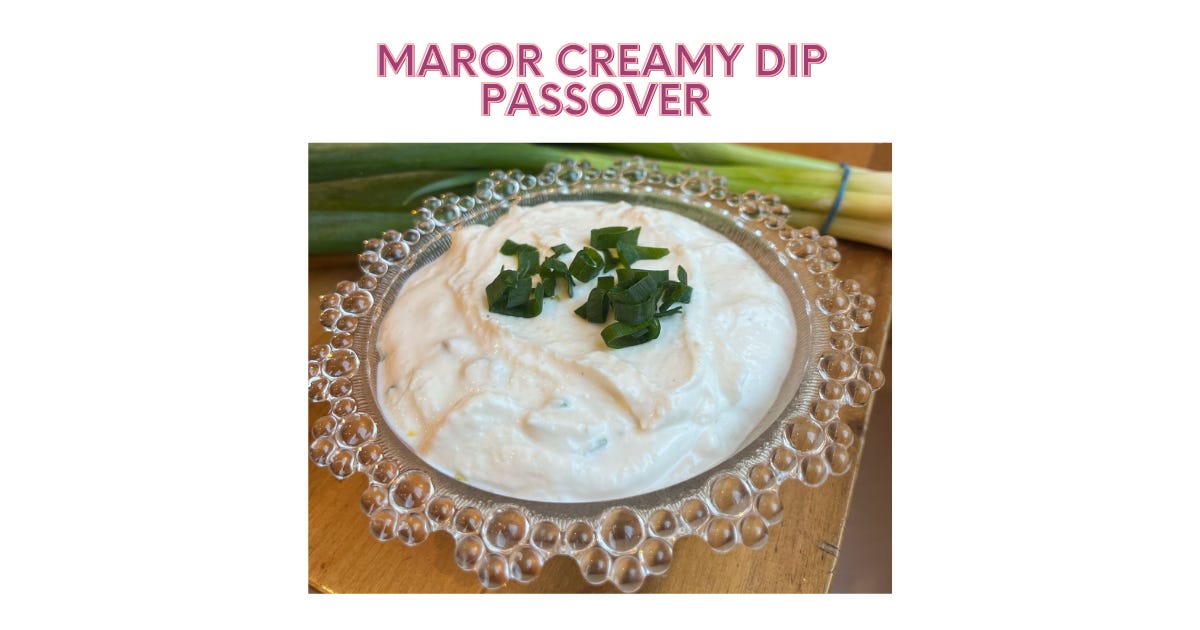I think most of us have our Passover menus set, sticking with the same beloved recipes year after year. And honestly, I love that tradition.
That’s why I wanted to offer an easy recipe to sneak into your lineup—voilà! This Passover Maror Creamy Dip is a fresh take on tradition, blending creamy Skyr and Greek yogurt with the bold bite of horseradish.
Horseradish, or Maror, has been a staple of the Passover Seder for centuries, symbolizing the bitterness of slavery. But beyond its symbolic meaning, its sinus-clearing heat and peppery intensity make it a powerhouse ingredient all year round. The sharpness of horseradish combined with the brightness of lemon zest creates a flavor balance—bitter and sour, bold and refreshing.
Once you try it, you might just wonder why you don’t use horseradish more often!
Best for
Served as a dip for fresh vegetables
A topping for baked fish
Paired with baked potatoes (white and sweet)
As a matza spread
Horseradish is a root vegetable known for its sharp, pungent heat and sinus-clearing intensity. It belongs to the Brassicaceae family, which includes mustard, wasabi, and cabbage. When freshly grated, horseradish has a mild aroma, but once its cell walls are broken, an enzyme called myrosinase reacts with compounds in the root, producing allyl isothiocyanate—the same compound responsible for the spicy kick in mustard and wasabi. This reaction gives horseradish its signature heat, which is felt more in the nose and sinuses than on the tongue, unlike chili peppers, which contain capsaicin and create a burning sensation in the mouth.
Horseradish in Jewish Tradition
Horseradish is best known in Jewish cuisine as Maror, the "bitter herb" eaten at the Passover Seder to symbolize the bitterness of slavery in Egypt. While some communities use romaine lettuce (which has a mild bitterness), horseradish has become the more common choice, particularly among Ashkenazi Jews, due to its intense bite.
Culinary Uses
Beyond Passover, horseradish is widely used in cooking:
Condiments – It's a key ingredient in horseradish sauce, often mixed with mayonnaise or sour cream to accompany meats and fish.
Gefilte Fish – A classic pairing, as the heat of horseradish balances the mildness of the fish.
Cocktail Sauce – Used in seafood dishes, particularly with shrimp.
Eastern European Cuisine – It’s often served alongside roast meats, sausages, and pickled dishes.
Health Benefits
Horseradish isn't just about flavor—it also has medicinal properties:
Antibacterial & Antiviral – The compounds that create its heat also have natural antimicrobial effects.
Rich in Antioxidants – It contains glucosinolates, which support detoxification.
Clears Sinuses – The strong vapors help open nasal passages and relieve congestion.
Tasting and Adjusting
Horseradish’s potency varies depending on its freshness and how finely it's grated. Freshly grated horseradish will continue to develop heat over time. If you’re incorporating it into a dish, start small and adjust to taste—what seems mild at first can quickly become overpowering!
Prepared or Freshly Grated?
You can use either prepared horseradish or freshly grated horseradish for this dip, depending on what you have on hand. Prepared horseradish from a jar provides a milder, more consistent heat, making it easier to control the flavor. Freshly grated horseradish, however, has a sharper, more intense heat that can change as it sits. If you choose fresh horseradish, start with a small amount and taste as you go, since it can quickly become overpowering. Both work well, but freshly grated will give the dip a more vibrant kick.
Passover Maror Creamy Dip (Dairy)
Ingredients:
1 cup Skyr yogurt
1 cup full-fat Greek yogurt
1 Tbsp horseradish or kosher for Passover prepared horseradish (more to taste)
1 clove garlic, minced (or more to taste)
1 scallion (green and white parts), minced
1 tsp olive oil
Lemon zest to taste
Dash of kosher for Passover onion salt (or kosher salt to taste)
Instructions:
In a bowl, whisk together Skyr and Greek yogurt until smooth.
Stir in the horseradish, garlic, scallion, olive oil, and lemon zest.
Add a dash of onion salt or kosher salt to taste.
Mix well and refrigerate for at least 30 minutes to let the flavors meld.
Serve chilled with matzah or fresh veggies.
For More Kick:
Extra horseradish (½ tsp more) – If you love the heat!
Black pepper or white pepper (a pinch) – Adds subtle warmth.
Hope you get a chance to try this Maror Dairy Dip during Passover!
What are you making for your Seder and throughout Passover week? I’d love to hear your ideas—please share your favorite recipes in the comments below!
To our healthy Passover!
Kenden










